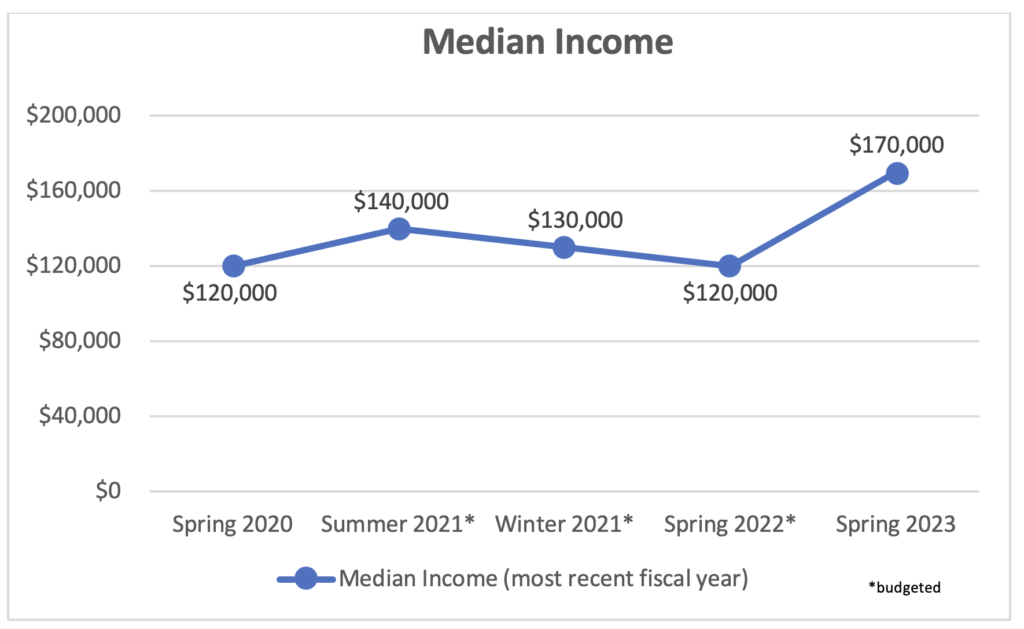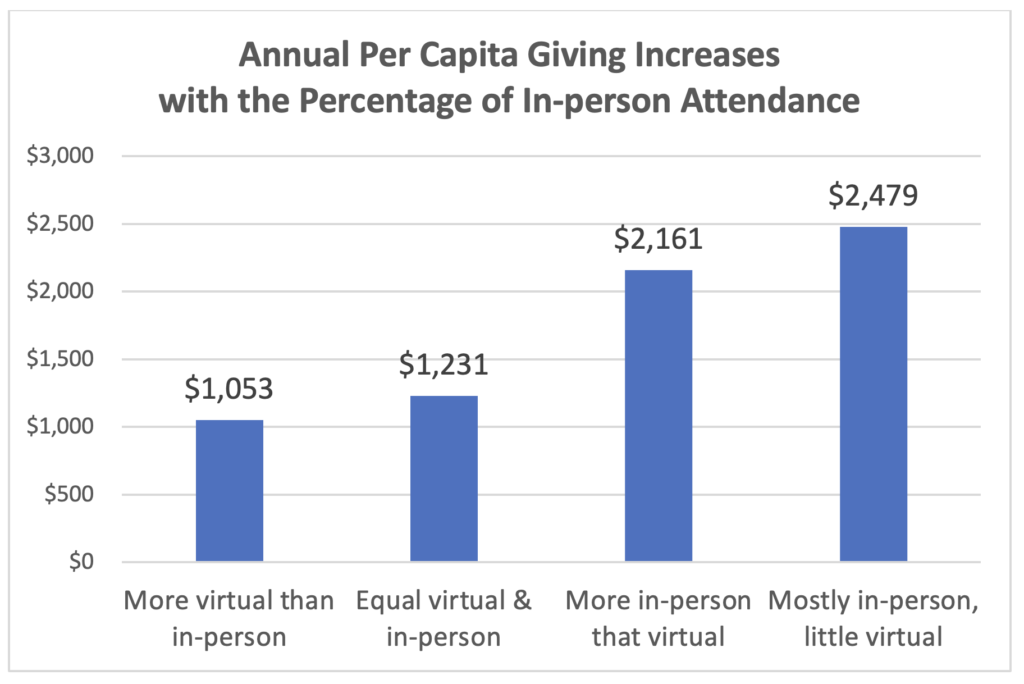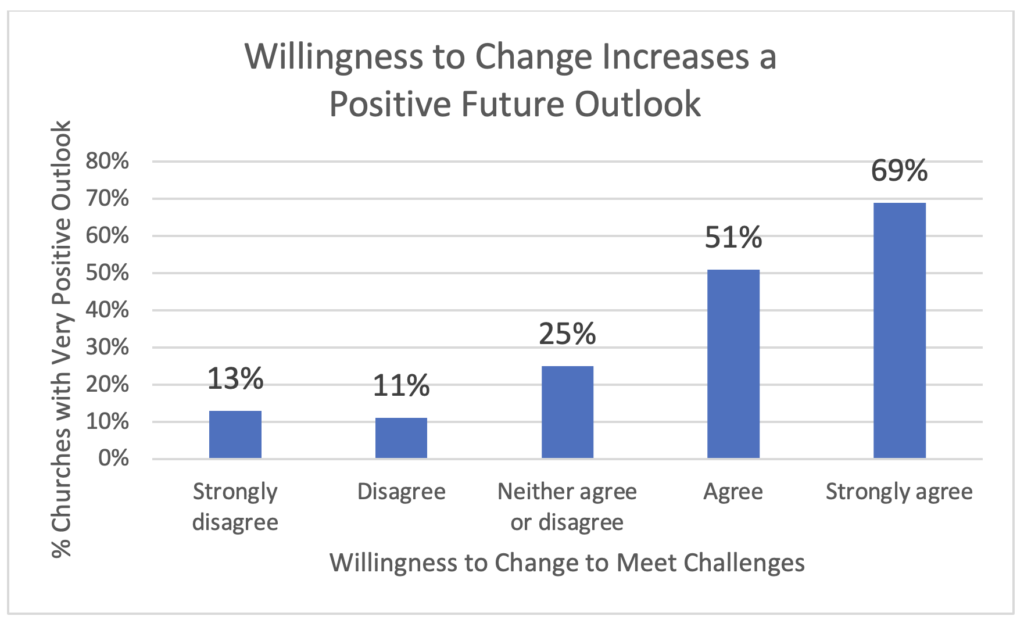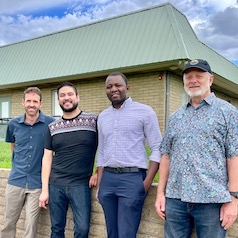2023 Giving Trends in Christian Congregations
2023 Giving Trends in Christian Congregations
Lake Institute always seeks to curate the most current data on faith and giving. We know the majority of faith-based giving in the U.S. goes to congregations. In this issue, we are proud to partner with our colleagues at Faith Communities Today (FACT) and Exploring the Pandemic Impact on Congregations (EPIC) to share with you the latest data on giving trends in Christian congregations.
by Scott Thumma, PhD
Faith communities have suffered considerably over the past three years as a result of COVID-19 and many other societal upheavals, but what hasn’t suffered much are the financial conditions of these churches. The median income of the nation’s churches is up nearly 42% from three years ago. Even adjusting for inflation, this still represents a remarkable increase of over 25% since 2020 (see Figure 1 based on Spring 2023 data from the Exploring the Pandemic Impact on Congregations and Faith Communities Today joint research of 58 Christian denominational groups and 4809 responses).
This income pattern mostly parallels national giving trends. Giving USA data released in June 2023 showed the pandemic needs of 2020 and 2021 propelled giving totals, and religious giving in particular, for those years to record-setting levels. However, religious giving in 2022, after adjusting for inflation, was down 2.6%, which is similar to what our 2022 research found. But our 2023 survey shows an increase in giving to congregations which likely indicates growth toward the end of last year and into this year. This fiscal pattern is positive and a good sign. It will be interesting to see if other research on giving finds a similar increase for 2023 and beyond.
It is interesting that this income growth didn’t have a commensurate rise in their assessment of their fiscal health. The growth in income did not translate into a significantly more positive assessment of the congregation’s financial health compared to their self-perception of five years earlier. Generally, only 22% of churches said their fiscal health was better now than previously, while 27% said it was worse.
It is hard to know definitively what accounts for the significant uptick in the 2023 results, but analysis of our survey and earlier research found that the more a church emphasized online and electronic giving, the greater their per capita giving rose. Congregations in our study without online giving had a per capita annual giving of $1,809, those with “a little use” saw giving rise to $2,052, “some use” jumped to $2,388, and “a lot of use” resulted in per capita giving of $2,428 – almost a 30% increase over those not using it. Not only has online giving increased since the pandemic, but it is being given greater emphasis now. Only 31% of churches reported using online giving in 2015 and just 8% did so a lot, whereas in 2023, 67% do so and nearly half (48%) use this method a lot. Additionally, postponed capital campaigns and fundraising events being restarted may contribute to this increase as might the sense of giving out of anxiety to keep the congregation afloat.
The financial picture varies with faith tradition. Because Catholic and Orthodox churches are generally larger, so too were their annual income, followed by Conservative and then Mainline Protestants. Viewed as per capita giving, the picture is reversed. Mainline Protestants contribute more annually per capita, at a median of $2,748 per person compared to $2,100 for Conservative Protestants, and $1,581 for Catholic and Orthodox participants.
How a church offers worship also affects giving. The small percentage of churches (1.5%) that only provide worship online have a median size of 10 persons and per capital giving of $691. A church that chooses to offer only in-person worship (25%) averages a median attendance of 35 and per capita giving of $2,048. However, 73% of churches offer a hybrid model of worship with both in person and virtual participation. These hybrid congregations have an average size of 90 people in worship and per capita giving of $2,350. Therefore, in terms of strengthening the congregation with attendance and giving, hybridity seems to be the strategic choice.
To look at how hybrid worship changes congregational dynamics and giving, we constructed a ratio scale of the number of persons attending worship virtually compared to those in-person. This scale was categorized into four groups – many more virtual than in-person, roughly equal percentages of virtual and in-person, some more in-person than virtual, and much more in-person attendance than virtually. We found that a significantly large percentage of hybrid congregations are comprised predominantly of in-person worship attendees.
Likewise, the per capita giving rates across this hybrid church spectrum show considerable variation. The greater the in-person over virtual ratio, the larger the per capita giving amount. In other words, in-person attenders give more than their virtual counterparts (see Figure 2). Virtual attendees are more likely to be passive spectators than active and engaged participants in the church’s life and coffers. Financially, the best option would be a church that promoted an online worship option but had a large majority of attenders participating in person.
Online giving seems exactly opposite to the virtual attendance pattern. The more that giving is done through online or EBT means, the greater the income. On average 40% of monthly giving is now done by online methods, with approximately 34% of the participants donating in this fashion. Interestingly, Catholic and Orthodox congregations lead the way in online giving with 83% of their churches having this option compared to 70% of Conservative Protestant congregations and just 59% of Mainline Protestant churches. Catholic and Orthodox churches are also far more likely to use online giving “a lot,” with 61% doing so, compared to 50% and 38% respectively.
In relation to other assets, most churches own their buildings (63%), or the buildings are owned by the denomination (24%). Relatively few of them rent (9%) or have free use (2%) of their buildings. Roughly 40% say they have more space than they need in these structures, and they are quite generous with this excess. Forty-one percent offer space to other organizations, and often this involves hosting many different groups. Of those sharing space, 52% do so for nonprofits like Scouts and food pantries, 36% provide support groups such as 12-step programs a place to meet, 33% schools and day care, and 33% other churches. Relatively few churches (16%) share with governmental agencies for functions like voting or civic meetings and very few (8%) provide for-profit groups with space. Interestingly, more of this space is given away free of charge (64%) than charged rent (41%) or an expense sharing arrangement (17%).
Clearly, congregations from the Mainline Protestant tradition lead the way in sharing their space with 59% doing so compared to 36% of Conservative Protestants and 21% of Catholic/Orthodox congregations. Mainline groups are also the most likely to say they have more space than they need (51%) compared to the other faith families.
Overall, there is much to celebrate in our most recent research, though congregational dynamics have not yet settled into a new norm. One thing is certain from our data, though, the mindset of the church and its leadership have a formative effect during post-pandemic adaptation. The more willing a church is to change and adapt, the greater likelihood it will envision a positive future (see Figure 3).
Whether these congregations will live into this robust future remains to be seen, but at the moment, things do look brighter financially.
 Scott Thumma, PhD serves as the Principal Investigator of Exploring the Pandemic Impact on Congregations (EPIC). He is Professor of Sociology of Religion at Hartford International University for Religion and Peace and the Director of the Hartford Institute for Religion Research. He is the co-chair of the Faith Communities Today project and on the steering committee of the US Religious Census, as well as research advisor for several other projects and organizations. Throughout his 30-year career he has participated in many congregational study projects and national religion research efforts. He has written widely on the subject of megachurches, gay religious life, congregational dynamics, and nondenominational churches and has published three books, many research reports, and managed over a half-dozen websites.
Scott Thumma, PhD serves as the Principal Investigator of Exploring the Pandemic Impact on Congregations (EPIC). He is Professor of Sociology of Religion at Hartford International University for Religion and Peace and the Director of the Hartford Institute for Religion Research. He is the co-chair of the Faith Communities Today project and on the steering committee of the US Religious Census, as well as research advisor for several other projects and organizations. Throughout his 30-year career he has participated in many congregational study projects and national religion research efforts. He has written widely on the subject of megachurches, gay religious life, congregational dynamics, and nondenominational churches and has published three books, many research reports, and managed over a half-dozen websites.
Questions for Reflection
-
- What story can be told with the numbers shared in this article?
- Where do you find your congregation in these numbers?
Expanded Perspective: Hispanic Congregations and Finances
by Rev. Kristina I. Lizardy-Hajbi, PhD
Hispanics/Latinos constitute the fastest growing U.S. racial-ethnic group. Data analyzed from the 2020 Faith Communities Today (FACT) Survey and the Exploring the Pandemic impact on Congregations (EPIC) Research Project reveals a complex snapshot of Hispanic congregational life. Below are five noteworthy findings based on an analysis of majority Hispanic congregations (faith communities that report at least 50% of their total participants as Hispanic/Latino).
- A majority of Hispanic congregations have experienced growth or remained stable in attendance over the past five years. Approximately four in ten (43.6%) Latino faith communities experienced attendance growth of more than 5.0% over the last five years, and 18.2% remain relatively stable. However, as faith communities in which a greater percentage of members earn less income than other congregations, they report a median annual income of $100,000 ($20,000 less than the median income for all congregations measured at the same time).
- Nearly quadruple the average percentage of Hispanic congregational income comes from particular fundraising events when compared with overall congregational income. Interestingly, an average of 17.1% of Latino congregational income is derived from fundraising efforts, compared with an average of 4.0% for all congregations. In this regard, the ability to garner funds through creative means seems to be unique to majority Hispanic congregations and invites further inquiry into best practices garnered by these faith communities.
- Regardless of whether Latino congregational leaders are full-time or part-time, over one third have paid employment outside of their congregation. Overall, two in ten leaders are unpaid for their congregational roles. Approximately 22.0% of majority Hispanic congregational leaders are in unpaid ministry positions, compared to only 13.7% of leaders in all other congregations. This may account for the increased median number of hours per week that leaders of majority Latino faith communities work outside of their congregational roles (40 hours) in juxtaposition to majority non-Latino congregational leaders (25 hours).
- Majority Hispanic congregations are half as likely to own their own facilities (34.7%) than other congregations (64.8%) and almost three times more likely to worship in the same building as other congregations. These realities may be due partly to these congregations having a median founding date of 1991. Latino congregations with a relatively stable average worship attendance over the past five years are the most likely to rent their worship and program space from other entities, with over half (54.4%) indicating that they do not own their space or have free use of it.
- Majority Latino faith communities are more actively engaged in activities beyond their congregation than other congregations. Half (50.2%) of majority Latino congregations place “a lot” of emphasis on community service activities, compared to 33.3% of all other congregations. Youth (37.1%) and young adult (22.6%) community activities, as well as global ministry activities (32.2%), are also emphasized “a lot.” Nearly half (48.2%) of Latino congregations report at least “some” emphasis on social justice/advocacy groups or activities, compared to 29.7% of all other congregations.
In general, these faith communities are optimistic about their futures, including financial futures. On the whole, Hispanic congregations report that their financial health is better today than it was five years ago, even as the COVID-19 pandemic created unique challenges for all U.S. congregations. As faith communities continue to return to a “new normal” from the disruptions of the pandemic, it remains to be seen how this ultimately will impact Latino congregations in the coming years. One thing is certain: Hispanic faith communities are a thriving and enduring facet of U.S. congregational life, something all congregations can recognize and celebrate during Hispanic Heritage Month.
 Rev. Kristina Lizardy-Hajbi, PhD is Assistant Professor of Leadership and Formation and Director of the Office of Professional Formation at Iliff School of Theology. Lizardy-Hajbi is an interdisciplinary scholar who teaches in the fields of leadership theory and praxis, congregational and community formation and change, practical theology, and applied research methods. She is the author of the report “American Congregations 2015 Engaging Young Adults” outlining the state of young adult presence and ministry in U.S. congregational life based on the results of the Faith Communities Today (FACT) Survey and was also the first co-chair of the Cooperative Congregational Studies Partnership, the multi-faith association of researchers responsible for the FACT National Survey of Congregations.
Rev. Kristina Lizardy-Hajbi, PhD is Assistant Professor of Leadership and Formation and Director of the Office of Professional Formation at Iliff School of Theology. Lizardy-Hajbi is an interdisciplinary scholar who teaches in the fields of leadership theory and praxis, congregational and community formation and change, practical theology, and applied research methods. She is the author of the report “American Congregations 2015 Engaging Young Adults” outlining the state of young adult presence and ministry in U.S. congregational life based on the results of the Faith Communities Today (FACT) Survey and was also the first co-chair of the Cooperative Congregational Studies Partnership, the multi-faith association of researchers responsible for the FACT National Survey of Congregations.
Latinx Philanthropy
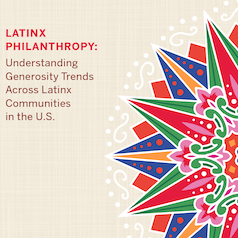 Latinx donors in the United States emphasize family, faith, and local communities in their giving and are significantly more likely to engage in informal giving compared to non-Latinx households, according to a new report released last month by Hispanics in Philanthropy and the Indiana University Lilly Family School of Philanthropy.
Latinx donors in the United States emphasize family, faith, and local communities in their giving and are significantly more likely to engage in informal giving compared to non-Latinx households, according to a new report released last month by Hispanics in Philanthropy and the Indiana University Lilly Family School of Philanthropy.
Latinx Philanthropy: Understanding Generosity Trends Across Latinx Communities in the U.S. provides new insights into dynamic patterns and long-term trends of Latinx philanthropy. It offers recommendations for donors, nonprofits and fundraisers on variations among Latinx giving, barriers and challenges for Latinx nonprofits and trends to watch. The data and information in the report stem from literature reviews, three major surveys, and two Latinx focus groups comprised of donors, philanthropic advisors and nonprofit professionals.
A 'Crazy' Idea with Great Results
Here’s another entry from our Faithful Generosity Story Shelf. In this story, read about an English-speaking Seventh-Day Adventist church that donates a $1 million dollar property to a Spanish-speaking Seventh-Day Adventist church.
Each entry in our Story Shelf is short enough to be read and discussed during a committee meeting or other group gathering. Our hope is that these accessible vignettes will spark new questions, conversation, and imagination among clergy and laity about what might be possible with the funds, buildings, land, and other resources in their care.
Subscribe
Insights is a bi-weekly e-newsletter for the religious community and fundraisers of faith-based organizations that provides:
- Reflections on important developments in the field of faith and giving
- Recommended books, studies and articles
- Upcoming Lake Institute events


